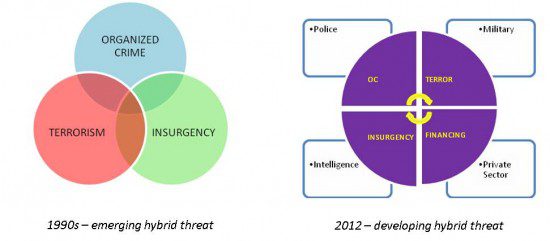In this well written blog post, Louis DeAnda described the emerging threats of terrorism, insurgency and organized crime and how they are blending to present a new threat profile that the country should be preparing to address. We like the overall holistic view and development of a framework that demonstrates the thtreats and roles involved in this National Security challenge.
 This article examines the evolving Hybrid Threat, its potential to pose existential threats to homeland security, its resistance to conventional, unilateral approaches and countermeasures, and proposes a highly cohesive, multi-dimensional approach merging Enterprise Theory of Investigation and military special operations targeting as the foundation.
This article examines the evolving Hybrid Threat, its potential to pose existential threats to homeland security, its resistance to conventional, unilateral approaches and countermeasures, and proposes a highly cohesive, multi-dimensional approach merging Enterprise Theory of Investigation and military special operations targeting as the foundation.
As we have been writing for sometime, the threat of a dirty bomb from cesium 137 (Medical Use Radiological Materials – MURM) is a perfect example of how this type of emerging hybrid criminal organization could cause mass casualties, damage the economy, security and public confidence.
In a related story, Australia has recently barred almost 1,500 employees from entering sensitive areas that contain nuclear or biological materials – including hospitals, airports, seaports and others. The program conducted widespread backgound check with the following results:
“In all, 334,317 AusCheck examinations have revealed thousands more workers with criminal backgrounds not substantive enough to bar them from working in the sensitive areas covered by the program. More than 900 of the barred workers were deemed ineligible due to a history of acts of violence. Close to 400 more were disqualified for selling drugs in the past.”
 Australia has traditionally been vigilent in its’ vetting programs in sensitive areas. When physician terrorists surfaced in the UK, Australia immediately conducted in-depth reviews of Foreign Medical Graduates (FMGs) and were started to find significant falsifications in the areas of professional qualifications, including forged documents of advanced medical training, non-existant peer recommendations, etc. They took appropriate actions. Even setting aside the potential for terrorism, getting these individuals out of the system resulted in a safer environment for the trusting public.
Australia has traditionally been vigilent in its’ vetting programs in sensitive areas. When physician terrorists surfaced in the UK, Australia immediately conducted in-depth reviews of Foreign Medical Graduates (FMGs) and were started to find significant falsifications in the areas of professional qualifications, including forged documents of advanced medical training, non-existant peer recommendations, etc. They took appropriate actions. Even setting aside the potential for terrorism, getting these individuals out of the system resulted in a safer environment for the trusting public.
Could we learn something from all of these examples in America?  Â






0 Comments